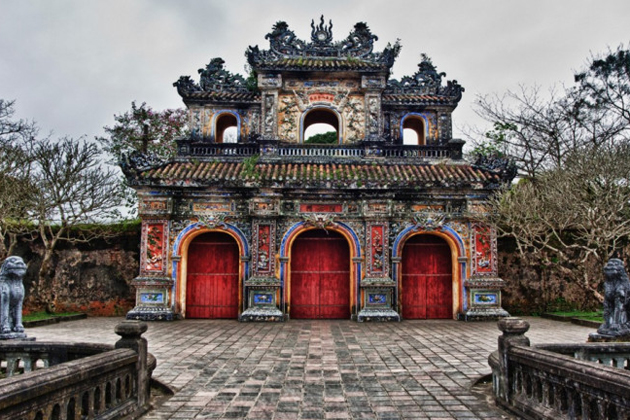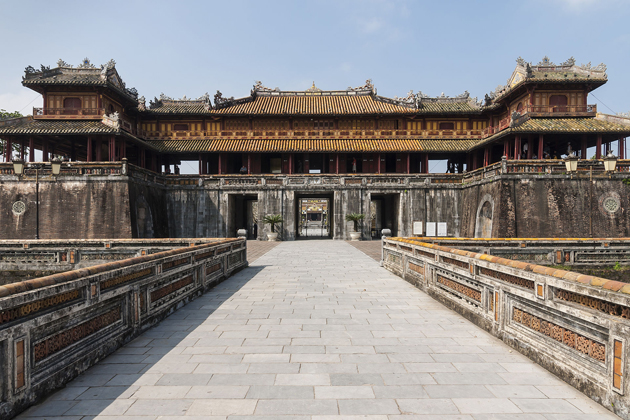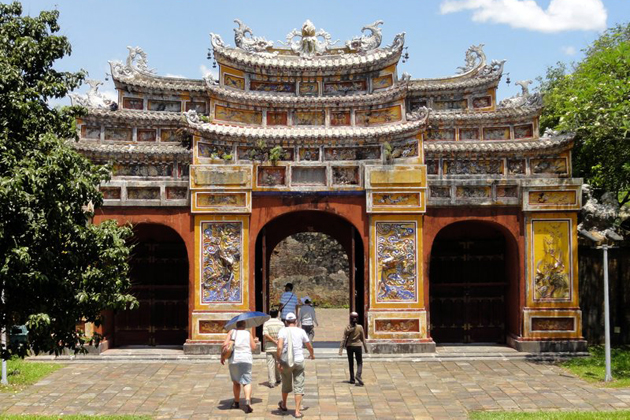The Imperial Enclosure is a historic centre and a distinguish architecture lying inside Hue Imperial City which was recognized as World Heritage by UNESCO on November 11th, 1993. It is where emperors’ accommodation and other main buildings such as temples, and palaces were established.
History and location
It took nearly 30 years to build The Imperial Enclosure, from 1805 under Gia Long King to 1832 under Minh Mang King. During the late modern period, maybe this architectural structure was the most gigantic one with thousands of workers involved in the constructing process, millions of cubic meters of rock used, and numerous tasks included such as trenches digging, river filling, immigrating, graves moving and wall building.
On the map, in the South, it now shares the border with Tran Hung Dao and Le Duan streets, with Le Duan street in the West, with Tang Bat Ho street in the North, with Phan Dang Luu street in the East.
In the past, right after his succeeding as a King, Gia Long had investigated a proper place for his palace. And he finally chose a large land beside the North bank of Perfume River. According to Feng Shui, in front of the enclosure is Ngu Binh mountain with 100 meter high, flat top and beautiful shape, playing the role as a natural partition of the citadel, and its two sides is Hen and Da Vien hillocks which respectively represent Green Dragon and White Tiger to show the spiritual power of the King.

The structure of the Imperial Enclosure
In general, the wall of the enclosure is 10km peripheral, 6.6m high, 21m thick and was built sinuously by mud at first and then by bricks at the end of Gia Long’s reign. Outside of the wall, there is a trench system for defend. There are 10 gates leading in the site which is Chinh Bac, Tay Bac, Chinh Tay, Tay Nam, Chinh Nam. Quang Duc, The Nhon, Dong Nam, Chinh Dong, Dong Bac.
Going inside, the Imperial Enclosure contains Imperial City serving the service as a protection of the most vital palaces and temples and Purple Forbidden City – a separated place for the kings and the royal.
The Imperial City has 4 gates and the main one is Meridian Gate (Ngo Mon). Imperial City and all the palace system inside were constructed according to an axis of symmetry, and those constructions that were specifically built for the Kings were located in the middle of the axis. Other constructions were strictly organized based on the regulations: left side for men and for those who were specialized in literature, right side for women and for martial art masters. Although there are myriad numbers of works regardless of their sizes, all of them are surrounded by the nature such as lakes, gardens, stone bridges and shade trees. The floor tiles, usually green or yellow glazed, were all originated from Bat Trang village, and the roofs were also covered by a special kind of tiles called green or yellow lapis lazuli. Inside the places, the walls were always decorated by numerous ancient Chinese poetries and paintings.
Purple Forbidden City was originated from a tale. It was said that in heaven, the God’s Palace was called Tu Vi Vien, meaning a purple garden. Kings were God’s sons; therefore, their living place should also be called purple. And Forbidden City means Cam Thanh, showing that residents couldn’t freely enter the place. The Purple Forbidden City has about 50 works with different sizes which are divided into many areas; the total works fluctuated according to different periods of time.
The architectural structure between Imperial City and Purple Forbidden City is strongly related in terms of distributing the works based on their functions. Purple Forbidden City lies inside the Imperial City; both two Cities have a mutual palace system usually named Royal Palace.
Some main palaces inside of the Forbidden City are Can Chanh Palace – the place where the kings worked. Behind Can Chanh Palace is Noi Dinh where the kings ate and did some recreational activities. Can Thanh Palace was the place for kings to live, in front of the palace lies a large yard and lotus lake. All of the king’s wives lived in Khon Thai Palace.

Some relics in Imperial City
Meridian Gate (Ngo Mon): the main gate in the South of the citadel which was built in 1833. Meridian Gate – the biggest gate among the four ones leading to Imperial City – in its literal meaning is “the gate during midday” or “the gate that face the South – the direction for Royals specifically”. This is the place that witnessed many essential events. Many of the most important festivals during Nguyen Dynasty took place here such as Ban Soc festival (to issue new calendar), Truyen Lo festival (to announce the new scholars), etc. The most distinguish one may be Abdication Declaration of Bao Dai king – the last king of Vietnam – and passed the power to the government of Socialist Republic of Vietnam.
Thai Hoa Palace: the palace lies inside of the citadel. The palace, along with the courtyard, used to be used just for vital rituals such as coronation events, king’s birthday celebrities, welcoming foreign envoys
Trieu To Temple: also called Trieu Temple, was built in 1804. The temple is in the North of Thai Temple inside Imperial Citadel. This is the place where Nguyen Kim – Nguyen Hoang’s father was adored.
Hung To Temple (Hung Temple): worshiped Gia Long’s parents –Mr. Nguyen Phuc Luan and Mrs. Nguyen Thi Hoan
The To Temple (The Temple): the former Nguyen Kings were adored here but female royals (even the empress) couldn’t take part in those kinds of events when they happened.

Hien Lam Pavilion: began being built in 1821 and finished in 1822, and is located in the temple area of Hue Citadel. It is 17m high – the highest construction of the citadel.
Nine Censers: they are placed in front of Hien Lam Pavilion, opposite Thien Temple. Each copper censer has its own name which is named after the name of every king of Nguyen Dynasty. They have different weights, different surrounding engraved patterns. They are respectively Cao Censer, Nhan Censer, Chuong Censer, Anh Censer, Nghi Censer, Thuan Censer, Tuyen Censer, Du Censer and Huyen Censer.
Copper Cauldrons: Nowadays, Hue Citadel has 15 copper cauldrons which all are artworks representing mastery casting and decorating ability of Vietnamese craftsmen. 4 out of 15 cauldrons were casted during Minh Mang king’s reign and the rest were casted during other kings’ reign.


